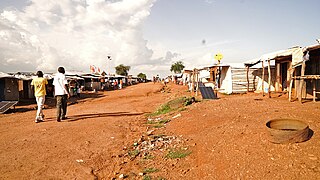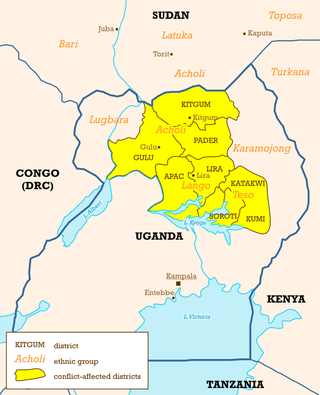
A refugee camp is a temporary settlement built to receive refugees and people in refugee-like situations. Refugee camps usually accommodate displaced people who have fled their home country, but camps are also made for internally displaced people. Usually, refugees seek asylum after they have escaped war in their home countries, but some camps also house environmental and economic migrants. Camps with over a hundred thousand people are common, but as of 2012, the average-sized camp housed around 11,400. They are usually built and run by a government, the United Nations, international organizations, or non-governmental organization. Unofficial refugee camps, such as Idomeni in Greece or the Calais jungle in France, are where refugees are largely left without the support of governments or international organizations.
By January 2011 the United Nations High Commissioner for Refugees (UNHCR) estimated that there are 262,900 Sudanese refugees in Chad. The majority of them left Sudan escaping from the violence of the ongoing Darfur crisis, which began in 2003. UNHCR has given the Sudanese refugees shelter in 12 different camps situated along the Chad–Sudan border. The most pressing issues UNHCR has to deal with in the refugee camps in Chad are related to insecurity in the camps,, malnutrition, access to water, HIV and AIDS, and education.

Nakivale refugee settlement is a settlement located in Isingiro District near the Tanzania border in Southwest Uganda.
Kyangwali Refugee Settlement is a refugee camp in the Kibuube District in western Uganda. April 2024, Kyangwali is home to 137,183 Refugees.

Rhino Camp Refugee Settlement is a refugee camp located in the districts of Madi-Okollo and Terego District in North Western Uganda.
Kyaka II Refugee Settlement is a refugee camp in Kyegegwa District in western Uganda.
Pagirinya Refugee Settlement is a refugee camp in Eastern Adjumani District in Northern Uganda.

Bidibidi Refugee Settlement is a refugee camp located in Yumbe District's West Nile sub-Region in Uganda. It is one of the world’s largest refugee settlements, housing approximately 285,000 refugees fleeing conflict in South Sudan as of late 2016. In 2017, and refugees from DR congo. it was described as the largest refugee settlement site in the world, and in 2023, it was labeled "Africa’s largest refugee camp" by The Guardian.

Uganda is one of the largest refugee-hosting nations in the world, with 1,529,904 refugees. The vast influx of refugees is due to several factors in Uganda's neighboring countries, especially war and violence in South Sudan and the Democratic Republic of the Congo, and associated economic crisis and political instability in the region. Uganda has relatively 'friendly' policies that provide rights to the refugees, such as rights to education, work, private property, healthcare and other basic social services.
Imvepi Refugee Settlement is a refugee camp in Terego District in West Nile Sub Region of northwestern Uganda.
Nyumanzi Refugee Settlement is a refugee camp in Adjumani District in northwestern Uganda. Established in 2014, it hosts about 52,000 South Sudanese refugees.
The Palorinya Refugee Settlement is a refugee camp in the Moyo District of the Northern Region of Uganda. The majority of the population fled the civil crisis in South Sudan in 2016.
Oruchinga Refugee Settlement is a refugee camp in Isingiro District in Southern Uganda.
The Elema Refugee Settlement is a refugee settlement in Adjumani district, westnile sub-region of Uganda. Elema was established in 1992 and stands to be the oldest refugee settlement out of the total of nine settlement in Adjumani district. The settlement is composed entirely of refugees from the Kuku tribe of South Sudan. The Kuku speak a Bari dialect, also called Kuku. They are chiefly a farming people relying on mixed farming. Following a UNHCR-led repatriation of South Sudanese refugees in 2008 from Uganda, the Kuku ethnic group in Elema declined to be repatriated.
Baratuku refugee settlement is a refugee settlement in the Adjumani district Uganda
Mungula II Refugee Settlement is a refugee camp found in Adjumani District Itirikwa subcounty in Northern Uganda.
Mungula refugee settlement is located in Adjumani district in northern Uganda on the border with South Sudan.
The Agojo refugee settlement is a refugee camp in the Adjumani District of Northern Uganda, opened in 2016 in response to an influx of South Sudanese refugees fleeing the insecurity in their country. It is located 16 kilometres (10 mi) west of the town of Adjumani.
Ayilo 1 refugee settlement is a prominent refugee camp located in Adjumani District, situated in the Northern Region of Uganda.

Lobule refugee settlement is a prominent refugee camp located in Koboko District, Northern Uganda.









